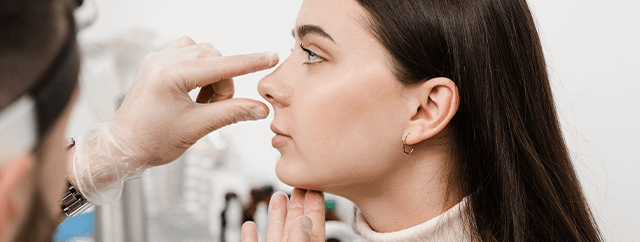Post Date: 9/15/2023

Rhinoplasty, also known as nose job, is one of the most common procedures in the field of aesthetic surgery. Candidates for this medical practice naturally have in mind the process of returning to daily life after the surgery.
Rhinoplasty surgery provides you with significant benefits both aesthetically and functionally. Since it is a surgical procedure, you may be curious about your recovery period and afterward, and you may have some concerns about this process. After the operation, changes will take place gradually, and the measures you need to take will change in the process.
In the first days after the operation, bruising and swelling occur on your face. These are natural and begin to decrease within the first week and completely disappear in a few weeks. When the first month is over, the swelling in your nose will be significantly reduced. It is recommended to spend this period at home if possible. You can find out what you will experience after rhinoplasty and what you should pay attention to in your daily life in consultation with Prof. Dr. Selçuk İnanlı.
Immediately after the operation, you will usually wake up feeling drowsy and perhaps a little uncomfortable from the anesthesia. The treated area will be carefully bandaged. Splints, tapes, and tampons will be placed inside your nostrils to provide support and reduce bleeding. These will be removed at a later date when the specialist deems it appropriate. It is also normal to feel some numbness or swelling around your nose and upper lip area.
In the first few days following rhinoplasty, you will usually experience a number of physical changes. Pain and discomfort are common, but these are usually managed effectively with prescribed pain medication. Swelling and bruising around your eyes and cheeks can be expected and usually peaks within the first 48 hours. This may look unfavorable and cause some temporary discomfort, but it is not permanent.
In the weeks and months following the surgery, you will see gradual improvements in the appearance and function of your nose. There comes a time when you begin to breathe comfortably. Swelling continues to decrease and the final results of rhinoplasty become more apparent. Again at this stage, it is important to bear in mind that it may take several months for you to fully recover and the nose will continue to develop in subtle ways.
In the long run, you will gain a new functionally advanced nose that is compatible with your desired aesthetic goals. However, each individual's rhinoplasty recovery experience may differ, so you should communicate clearly with your rhinoplasty specialist, explain your expectations well at the initial consultation, and follow their postoperative instructions to the letter. All this is very important to achieve the best possible result.
After undergoing rhinoplasty, there are several important considerations to keep in mind during the recovery process and beyond. First and foremost, it's crucial to follow your surgeon's post-operative instructions diligently. These guidelines are designed to ensure a safe and successful recovery. They may include instructions on medications, wound care, and activity restrictions. Ignoring or deviating from these instructions can lead to complications and hinder the healing process.
Maintaining a healthy lifestyle is another vital consideration after rhinoplasty. Proper nutrition, hydration, and getting adequate rest can aid in the body's healing process. Avoiding alcohol and tobacco is especially important, as these substances can slow down healing and increase the risk of complications. Smoking, in particular, can compromise blood flow to the surgical site and lead to tissue damage.
Protecting your nose from accidental bumps and trauma is critical, especially in the early stages of recovery when the nose is most vulnerable. Wearing glasses, participating in contact sports, or engaging in activities that could potentially injure the nose should be avoided as advised by your surgeon. Even after the initial recovery period, it's a good practice to be mindful of protecting your nose from harm.
Aside from the physical conditions after rhinoplasty, it is also important to be emotionally prepared for the psychological aspects of a surgical procedure. Many people choose this procedure to boost their self-esteem. However, it is very important that you have realistic expectations about the results. You can improve your appearance with a cosmetic operation, but you may not be able to completely change your life or how you feel about yourself. It is helpful to have good self-confidence and a positive outlook before and after surgery.
Finally, consider that long-term care is required for your results to last. Your nose may continue to heal little by little over time, perhaps longer than you think. Protecting the area from excessive sun exposure and traumatic injuries will help maintain your results for years to come. In addition, some people also consider incorporating different treatments such as dermal fillers to further improve their appearance or address minor imperfections. Prof. Dr. Selçuk İnanlı, who has performed countless successful rhinoplasty surgeries, answers all the questions that patients who come to his clinic have. Please contact us via the contact details.